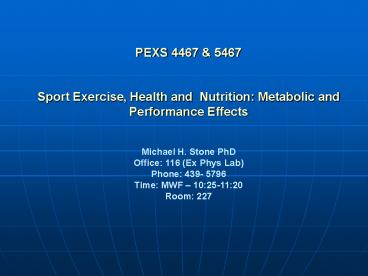PEXS 4467 - PowerPoint PPT Presentation
Title:
PEXS 4467
Description:
Basic Concepts Section 1:History ... To understand basic nutrition and how it effects metabolic processes and physical activity To understand how nutrition can ... – PowerPoint PPT presentation
Number of Views:81
Avg rating:3.0/5.0
Title: PEXS 4467
1
PEXS 4467 5467 Sport Exercise, Health and
Nutrition Metabolic and Performance Effects
Michael H. Stone PhD Office 116 (Ex Phys
Lab) Phone 439- 5796 Time MWF 1025-1120
Room 227
2
Basic Concepts Section 1History/Culture Section
2 Macronutrients Section 3 Micronutrients
H20 Section 4Digestion and Absorption Section
5Bioenergetics and metabolism role of
nutrients Applied Concepts Section
6Macronutrient metabolism during exercise and
training Section 7 Nutritional considerations
for exercise, health and disease Section
8Nutritional considerations for sport Section
9Ergogenic Aids
3
Course Requirements Written Tests 6 All
tests will be take home (possible exception is
final) these tests are accumulative Grades
grades are based on a competitive scale student
with highest number of points becomes 100 and
all other student grades are based on this
scaling factor Grading Scale A 93 100 C
77 79.9 F lt 60 A- 90 92.9 C 73
76.9 B 87 -89.9 C- 70 72.9 B 83
86.9 D 67 69.9 B- 80 82.9 D 60
66.9 Graduate Students paper (50 pts)
4
Tests take home Mostly multiple choice and
true false there will be some fill in the
blank. Tests will range from 25 - 50 questions.
There may be a short essay on the
final Sections 1 and 2 test Section 3
test Section 4 - test Section 5 and 6
test Section 7 test Section 8 and 9- test
5
Class Textbook McArdle, W.D., Katch, F.I. and
Katch, V.L. Sports Exercise Nutrtion (2nd
edition) Baltimore, Lippincott, Williams and
Wilkins. Useful Textbooks etc. AIS (Burke, L.
et. al.) Current Concepts in Sports Nutrition
Canberra, Australia, AIS See http//www.ais.or
g.au/nutrition/CurrentConcepts.asp
6
Notes etc. Each section will have power-point
lectures associated with it these can be
accessed on the web (I hope). There will be
readings associated with each section. There is
no date (day) associated specifically with each
lecture or with each test. It is not possible to
know exactly the length of each lecture and
question(s)/answer period.
7
- Syllabus PEXS 4467/5467
- Instructor Mike Stone
- Office E116 mini-dome
- Phone 439-5796
- Course Description the course is design to
provide in-depth information concerning the
inter-relation of exercise and nutrition.
Discussions will include the effects of nutrition
on sport, exercise for health and as an
intervention for metabolic diseases. - Course Objectives
- To understand basic nutrition and how it effects
metabolic processes and physical activity - To understand how nutrition can potentially
effect exercise and sports performance - To understand the potential role of exercise and
nutrition in health
8
- Content Outline
- Section 1 - Presentation 1 Historical/cultural
perspectives of exercise and sports science - History and creation of a discipline
- Brief discussion of the scientific method and
basic versus applied science - Differences between exercise and sports science
- Reading Stone, M.H. Sands W. and Stone M.E. The
Downfall of Sports Science in the United States.
Strength and Conditioning 26 (2) 72-75, 2004. - Section 2 The Macronutrients
- Sec 2 Presentation 1Carbohydrates
- types/structures
- Foods- dietary
- Storage (glycogen)
- Role in energy production
- Sec 2 Presentation 2 Lipids/Fats
- types/structures
9
Section 3 - The Micronutrients Sec 3
Presentation 1 Vitamins Types fat and water
soluble Function of vitamins dietary
needs Potential role in health disease Sec 3
Presentation 2 Minerals Types of
minerals Function of minerals and water -
bioavailability/dietary needs Potential role in
health disease Sec 3 Readings Chapter
2 Section 4 Digestion and Absorption of Macro
and Micronutrients Sec 4 Presentation 1
Digestion basic chemistry The basis for
digestion (hydrolysis and condensation) Enzymes
function/action Nutrient transport across
membranes Sec 4 Presentation 2 Digestion and
Absorption of food gastrointestinal tract
mouth/teethgt esophagusgtstomachgtsmall intestine
gtlarge intestine Sec 4 Presentation 2
Carbohydrate, Fat and Protein Digestion/ Vitamin
Absorption controlling hormones enzymatic
breakdown of food process of absorption Sec 4
Readings Chapter 3
10
Section 5 Bioenergetics and Metabolism Sec 5
Presentation 1 energy production and role of
macronutrients Importance of an energy conveyor
ATP Anaerobic and aerobic mechanisms of energy
production Importance of post-exercise energy
consumption Mechanisms of post-exercise energy
recovery Section 6 Measurement of Energy in
Food, during and post-exercise Sec
6Presentation 1 Energy in Energy out Energy
values of foods (gross versus net) Energy
requirements of physical activity
measurement Respiratory quotient (RQ) and
respiratory exchange ration (RER) Readings
Sections 5 and 6 Textbook chapters 4-6
11
Section 7 Nutritional considerations for
exercise, health and disease Sec 7 energy
balance and good nutrition energy balance
equation RDA carbohydrates, protein and fats -
is it enough? Vitamins, minerals and
exercise exercise/nutrition and the immune
system Exercise and food intake Sec 7
Readings Chapter 7 Section 8 Nutritional
Considerations for Sport importance of protein
and carbohydrate replenishing fuel stores high
fat versus low fat diets Section 8 Ergogenic
Aids nutritional and pharmaceutical
aids Readings chapters 8 and 11































